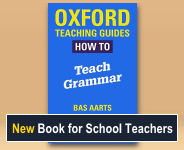Topic: Verb phrase
These resources cover verb phrases: phrases with a verb as the Head word. A verb phrase can have a main verb on its own (e.g. He gobbled the chocolate), or a main verb together with one or more helping verbs called auxiliary verbs (e.g. He is gobbling the chocolate; He has been gobbling chocolate all morning).
Englicious contains many resources for English language in schools, but the vast majority of them require you to register and log in first. For more information, see What is Englicious?

